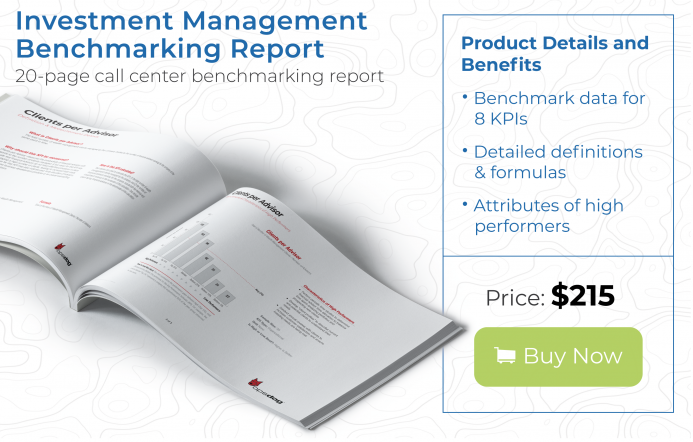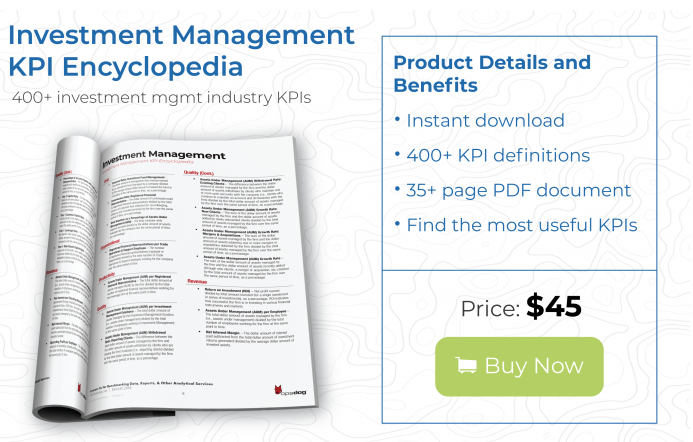Many financial institutions have investment management divisions that earn commissions on the client assets they manage. While investment management can be a lucrative source of revenue and supplemental profits, you’ll need to keep investment management operational costs as low as possible to weather market volatility that can impact portfolio values. One of the best ways to do this is by tracking Investment Management Key Performance Indicators or KPIs.
Why Offer Investment Management?
The investment management division of financial institutions often functions as a full-service brokerage, buying and selling assets such as stocks, bonds, options, and mutual funds. These products are offered through licensed financial representatives who may be financial institution employees or work for a separate broker/dealer on behalf of the bank.
The institution makes money by charging clients commissions on each trade as well as receiving fees for other services, such as investment advice and market research. The percentage earned on assets under management (AUM) for high-net-worth or ultra-high-net-worth clients can be substantial. Here is where investment management key performance indicators can come in handy.
In addition to investment management, financial institutions typically try to present clients with a full-service wealth management platform that includes retirement and estate planning and to offer a wide range of solutions such as IRAs, annuities, health savings accounts, and education savings plans.
The goal is to provide clients with holistic wealth management that encourages clients to invest more of their assets with the financial institution. But it’s also a highly competitive market. Financial institutions must compete with discount brokers such as Schwab and Fidelity that offer free or low-cost trading and with automated online investment platforms—or robo-advisors—that also offer low-cost services.
What are Investment Management KPIs for Financial Institutions?
An investment management key performance indicator (KPI) can be defined as various investment management or broker dealer-related metrics that are used as measurements of success throughout the process of providing asset management to clients of financial institutions.
There are several categories of investment management key performance indicators that you can use. The first has to do with returns—how much money you make or lose on an asset. While the investment prowess of your portfolio managers has an impact on portfolio growth, stock market performance plays an even larger role. In a bull market, returns tend to be high regardless of investment strategy. In a bear market, the opposite is true.
Although investment management departments have no control over market volatility and economic conditions, you can increase revenue by bringing in assets from new or existing clients and decreasing operational costs.
Many investment management KPIs therefore focus on the sales performance of registered financial representatives. For example, are your financial representatives bringing in enough new clients? Are they retaining clients and capturing more wallet share of these existing clients? Is there an outflow of assets?
KPIs can also measure overall investment management operational performance such as how well your investment team executes trades, how much time and effort it takes to onboard new clients, and how productive your financial representatives are.
Investment Management Key Performance Indicator Examples
Here are five common KPIs used by financial institutions that offer investment management services.
KPI Metric #1: Assets Under Management per Registered Financial Representative
Assets under management (AUM) are the assets that the firm manages on behalf of its clients. While you want each of your financial representatives to manage a high amount of assets, you also want to ensure that representatives are managing those assets properly and that clients are satisfied. If AUM per representative is low, look at the effectiveness of your business development or whether you have too many representatives on staff to manage too few assets.
To calculate, divide total AUM by the number of registered financial representatives. Include only representatives licensed to sell securities.
KPI Metric #2: New Equity Accounts per Investment Account Onboarding Employee
The onboarding process for equity accounts is relatively complex and there are multiple touch points that can add friction to the onboarding process. Measuring the average number of accounts that an employee can open provides a window into how efficient your onboarding process is.
To calculate, divide the number of new equity accounts (any account opened for the sole purpose of trading securities) by the number of onboarding employees. Do not include traders or support employees.
KPI Metric #3: Investment Management Fee Revenue as a Percentage of Assets Under Management
Investment management fee revenue is often, but not always, closely tied to your investment strategy. If your institution employs a more conservative approach to investments, it will tend to earn lower returns. Likewise, a more aggressive investment strategy may result in higher returns and therefore more revenue.
To calculate fee revenue, divide the dollar amount of fees by the total dollar amount of both retail and institutional account assets, as a percentage. Include fee revenue from portfolio management, financial counseling, brokerage, and other transactional services.
KPI Metric #4: Revenue per Client
Revenue per client is a basic metric of profitability and can tell you a lot about your client base. If your strategy is to attract more ultra-high-net or high-net-worth clients, tracking revenue per client lets you know if your marketing and growth strategy is working. But if you have a client base with high investable assets and revenues are lower than expected, ensure that you are investing any commissions you earned appropriately.
To calculate, divide total wealth management revenue by the number of investment management clients.
KPI Metric #5: Percentage of Inaccurate Equity Trade Records
Trading a large volume of assets in multiple transactions can move the market price. Block trades bundle trades together into a single block for an agreed-upon price, saving money for investors. But inaccurate, canceled, and re-billed block trades cost your institution money. To improve operational efficiency, monitor errors by type to identify the root cause and then eliminate any redundancy or manual efforts.
To calculate, divide the number of canceled and re-billed equity-related block trades by the number of block trades processed.
Final Thoughts
Investment management can provide your financial institution with an additional revenue source and allow it to diversify beyond deposits and lending. However, investment management is a different business model that is highly dependent on the performance of the institution’s financial representatives. KPIs can provide insight into how well representatives are performing.
There are many investment management key performance indicators to consider while building a KPI library, for a full list of asset management metrics download our Investment Management Key Performance Indicator Encyclopedia.
If you need additional help benchmarking against your peers or building a strong broker dealer KPI library, then help yourself to our presentation-ready Investment Management Benchmarking Report, or contact us for more information about our https://opsdog.com/services/benchmarking. We can help you quickly and efficiently benchmark your investment management operations and provide you with high-quality deliverables perfect for presentations at an affordable price.



